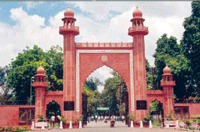Mostly in the news for shootouts, student unrest and sine die closures (on September 18 last year the university was shut down sine die after a student, the third since April of that year, was murdered on campus), Aligarh Muslim University (AMU, estb. 1885) is looking for ways and means to raise teaching-learning standards. To that end a 37-page report titled Potential of Raising the International Status of the Aligarh Muslim University made public on July 26, has suggested sweeping changes in the modus operandi of the 133-year-old university which has a massive 25,000 students in over 100 departments and centres.
The report is authored by a four member committee headed by Prof. M. Saleemuddin, a former vice chancellor of the university. Although it has discreetly steered clear of the recent controversies that have afflicted the university, it has offered extensive suggestions ranging from the appointment of the vice-chancellor and revision of syllabi, to interdisciplinary focus, research, semester system and even ways to deal with academic dishonesty and plagiarism.
 Certainly AMU, promoted by the eminent anglicised scholar and social reformer Sir Sayyed Ahmed Khan as the Mohammedan Anglo-Oriental College and modelled on Cambridge University, but which has since acquired the image of a provincial theological institution, urgently needs a makeover. “AMU has transformed into an insular institution over the years. Most of its students come under-prepared from UP and Bihar, thus its academic reputation and level of competitiveness have been severely hit. The faculty suffers from inbreeding. The university has to do a rethink of its ‘special’ status and initiate reforms on the lines suggested by the Saleemuddin Committee,” says Irfan Ahmed, secretary of the AMU Old Boys’ Association.
Certainly AMU, promoted by the eminent anglicised scholar and social reformer Sir Sayyed Ahmed Khan as the Mohammedan Anglo-Oriental College and modelled on Cambridge University, but which has since acquired the image of a provincial theological institution, urgently needs a makeover. “AMU has transformed into an insular institution over the years. Most of its students come under-prepared from UP and Bihar, thus its academic reputation and level of competitiveness have been severely hit. The faculty suffers from inbreeding. The university has to do a rethink of its ‘special’ status and initiate reforms on the lines suggested by the Saleemuddin Committee,” says Irfan Ahmed, secretary of the AMU Old Boys’ Association.
The committee’s recommendations made under 24 heads include the following:
Faculty development. The committee enjoins the university management to discourage inbreeding and attract talented teachers from various universities and prestigious institutions, both from within the country and abroad, interviewing them through video-conferencing if necessary; provide faculty with access to contemporary literature in their disciplines, full texts of important journals and set up a sophisticated instruments centre to cater to the needs of the faculties of science, life sciences, agriculture, and medicine, etc; to monitor academic accomplishments of each faculty member on an yearly basis and to base promotion on merit.
Asif Khan, a newly inducted teacher in the university’s history department admits that faculty upgradation and development is an urgent priority. “The academic vigour that is the hallmark of a great institution is missing in AMU. Nepotism is rife, and there’s been little genuine research in the past decade. The university does not figure in any annual list of rankings simply because it refuses to share information with the outside world. This is doing incalculable harm to its image. The only time AMU is in news is when violence erupts or when there are accusations of sexual harassment,” says Khan.
Admissions. To attract higher calibre students, the Saleemuddin Committee inter alia recommends admission of students in the undergrad programmes through all-India entrance tests; introducing distance education programmes in job-oriented courses as also in science subjects; reservation of 5-10 percent seats in undergrad and postgraduate courses for foreign students, and establishment of a Foreign Students’ Cell to liaise with foreign embassies and missions to publicise AMU.
Tuition fees. One of the most significant recommendations of the Saleemuddin Committee is a forthright call to the AMU board of governors to raise tuition fees and food charges in line with cost of living indices to “improve the quality of life and education/training on the campus”. Currently AMU, a predominantly residential institution (90 percent of the varsity’s 25,000 students live on campus in cramped, unhygienic conditions), charges annual tuition fees ranging between Rs.2,500 and 4,000 and Rs.275-285 per month for residential accommodation.
Among other notable recommend-ations the committee has made are a call for AMU to open itself up for accreditation by NAAC (National Assessment and Accreditation Council) and to media publications and organisations which evaluate and rank colleges and universities, and a compulsory study in ethics for all students.
While the report was submitted to the AMU board of governors on June 30, it has been made public on the university’s website (www.amu.ac.in) only recently to invite comments and suggestions. The Saleemuddin Committee which was appointed by AMU vice-chancellor P.K. Abdul Azis on June 23 last year with an initial tenure of just four weeks, has had its term extended to a year given the enormity of the task. “It is a reform agenda to recapture the academic glory of this great seat of learning and needs inputs from everyone,” says Azis.
Although the committee’s report has been widely welcomed by faculty, students and well-wishers of this ancient seat of learning, it is deafeningly silent about measures to control and contain recurrent student unrest and violence on campus. “Until there is an atmosphere of peace on the campus, no meaningful reforms can be effected,” says Saad Rais, a history alum of the university.
Vidya Pandit (Lucknow)